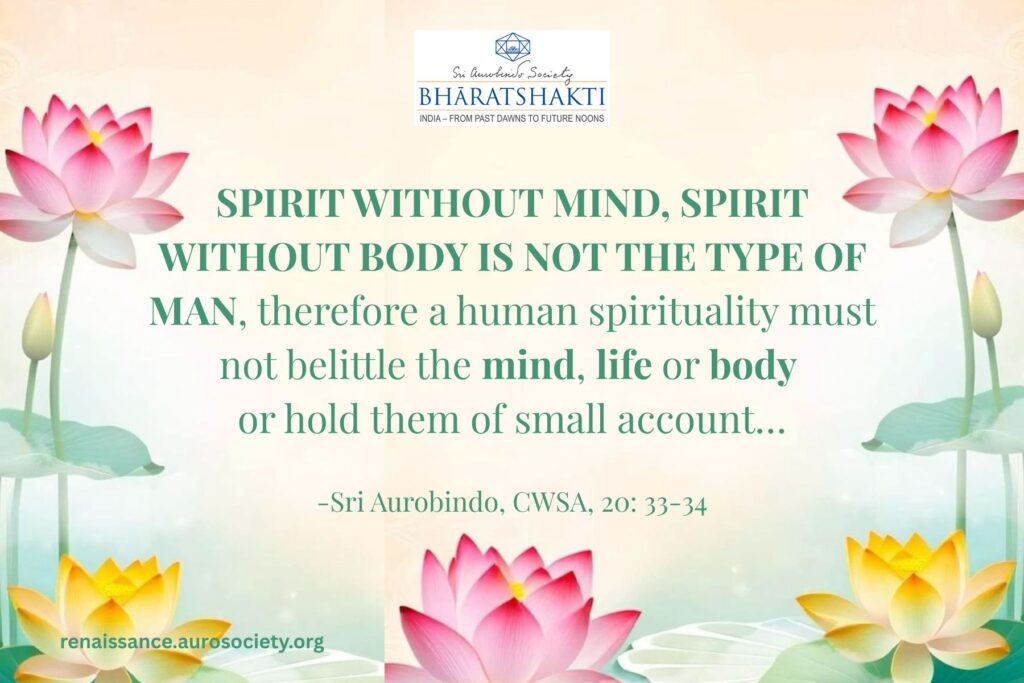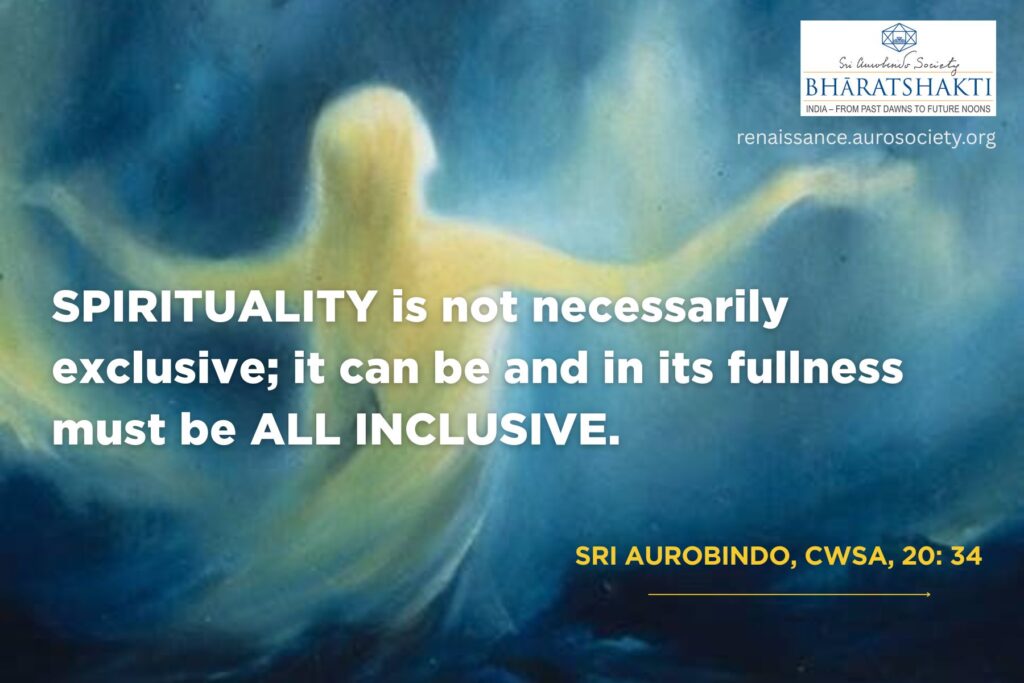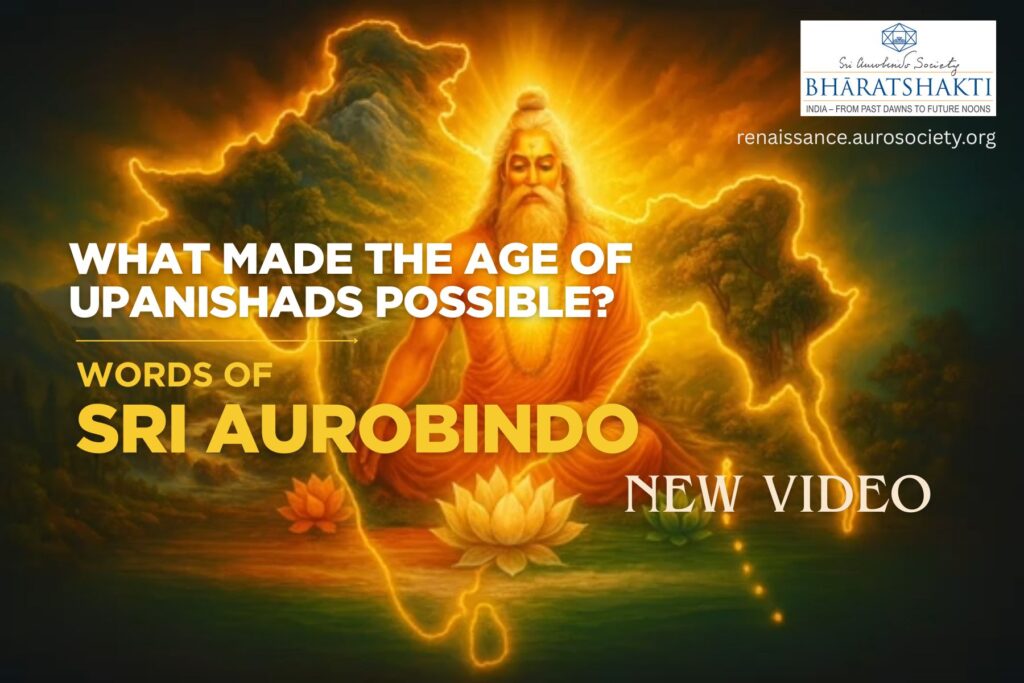Volume III, Issue 10
Author: Prema Nandakumar
CONTINUED FROM PART 3

Rama, the National Ideal
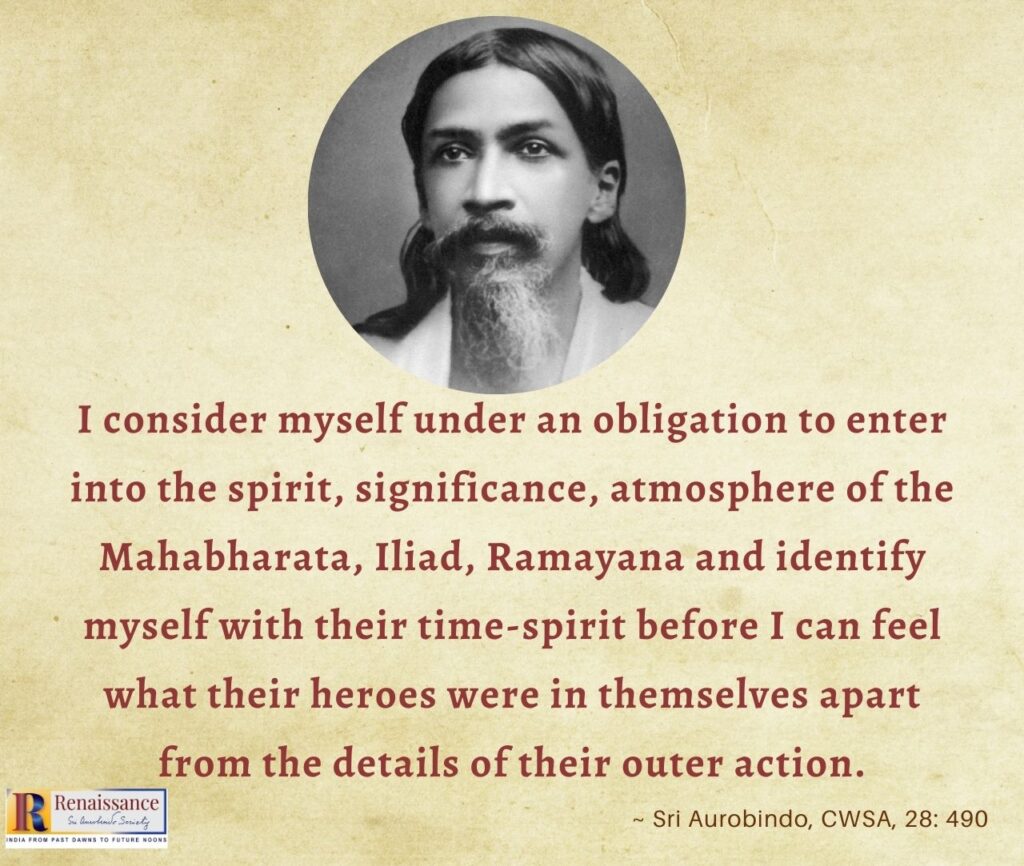
Even his first encounter with Indian legends had shown Sri Aurobindo that these were no mere stories spun by an idle imagination. Long before he took up the intuitive interpretation of the Vedas, he had decided that the Indian legends had to be interpreted as symbols.
The West had seen the Indian myths as barbaric. The westernised Indian also tended to condemn Hindu legends as “trivial and insipid, a mass of crude and monstrous conceptions, a lumber-room of Hindu banalities” (Sri Aurobindo, CWSA, Vol. 36, p. 125).
Even today myopic Indian intellectuals fed on the ‘honey-dew’ of English education dismiss the legends as “puerile Puranic stuff” (Iyengar, the Epic Beautiful, p. 16). Sri Aurobindo swam against the tide and put the record straight. He declared:
It is notable that the two vast Indian epics have been considered as much as Dharma shastras as great historico-mythic epic narratives, itihāsas.
They are, that is to say, noble, vivid and puissant pictures of life, but they utter and breathe throughout their course the law and ideal of a great and high ethical and religious spirit in life and aim in their highest intention at the idea of the Divine and the way of the mounting soul in the action of the world.
~ CWSA, Vol. 20, p. 227
Intense human dramas, yes; but also dramas of preparation for the life divine.
Hence the characters act out the legend in the foreground while the background lights up the ethical ideals they represent. The Ramayana is no old wives’ tale. When Valmiki writes, a marvellous meeting of a human act and an ethical ideal takes place giving rise to a permanent inspiration for future generations.
“The Ramayana embodied for the Indian imagination its highest and tenderest human ideals of character,” said Sri Aurobindo. And added that it:
- made strength and courage and gentleness and purity and fidelity and self-sacrifice familiar to it in the suavest and most harmonious forms coloured so as to attract the emotion and the aesthetic sense,
- stripped morals of all repellent austerity on one side or on the other of mere commonness
- and lent a certain high divineness to the ordinary things of life, conjugal and filial and maternal and fraternal feeling, the duty of the prince and leader and the loyalty of follower and subject, the greatness of the great and the truth and worth of the simple, toning things ethical to the beauty of a more psychical meaning by the glow of its ideal hues. (CWSA, Vol. 20, p. 350)
This passage explains the secret of the epic’s fascination.

***
Rama has been the national ideal for several thousands of years. An endless debate has raged around some of his actions. If he were Dharma incarnate, how could he kill Vali? Again, is Rama a human being like any of us, or is he an Avatar? Must we judge him as a man or as a God?
What should be our attitude to his stern rejection of Sita after winning the war in Lanka? Was he justified in remaining a silent spectator, unmoved, as Lakshmana prepared the fire and Sita entered it?
Where was manava dharma when he banished Sita who was carrying his child? Was it not rather unpardonable of Rama to ask Sita to prove her chastity again to the assembled court, in the presence of Lava and Kusa?
The Vali incident has engaged scholars and exegeticists for several centuries. Vali was undoubtedly a hero who did not deserve death engineered from an unexpected quarter. But Valmiki makes no excuses for Rama. He allows the dying Vali to have his say and Rama is allowed a reply, however unconvincing.
But why didn’t Rama kill Vali in a straight fight, nags our questioning mind. In our own times, Rajaji has given his version of the Ramayana where he solves the problem by holding on to the Avatar theory:
Against this accusation (of Vali) what defence could Rama offer? Valmiki has it that Rama gave some explanation with which Vali was satisfied. But I am omitting all this as pointless and pray that the learned may forgive me. What I think is that an avatar is an avatar and that among the sorrows that the Lord and His Consort had to endure in their earthly incarnation, this liability to have their actions weighed on the earthly scales is a part.”
~ Ramayana, 1962, p. 81
Another great scholar-statesman, V. S. Srinivasa Sastri has dealt with this controversy in detail in his Lectures on the Ramayana. His conclusion is that Rama suffered from human indecision first and later killed Vali by a spasmodic spurt of sudden action.
(For a fuller comparison of the views of Rajaji and V. S. Srinivasa Sastri on the controversial episodes in the epic, see ‘The Ramayana as Viewed by Two Modern Rishis’ included in my book, The Glory and the Good: Essays on Literature, 1965, pp. 1-16).
Sri Aurobindo does not take the Avatar-view or human-view in entirety. He reconciles the human being and the Avatar in the racial and universal contexts.
Cowardice is the last thing that can be charged against Valmiki’s Rama. . .
Valmiki everywhere paints him as a great warrior. His employment of ruse against an infrahuman enemy does not prove the opposite—for that is always how the human (even great warriors and hunters) has dealt with the infrahuman.
I think it is Madhusudan who has darkened Valmiki’s hero in Bengali eyes and turned him into a poor puppet, but that is not the authentic Rama who, say what one will, was a great epic figure,—Avatar or no Avatar. . .
. . . he [Rama] was the Avatar of the sattwic human mind—mental, emotional, moral—and he followed the Dharma of the age and race.
~ CWSA, Vol. 28, pp. 493-494
Sri Aurobindo felt that when dealing with the human personality of Rama one should get into the spirit of his age and race. Rama’s life should not be read as that of a modern man. That is the only way to understand the inconsistencies in his character.
The killing of Vali, the fire-ordeal of Sita, her banishment in the Uttara Kanda: these have to be seen from the angle of the heroic age of which Rama was a part.
Sri Aurobindo imparts common-sense to the critics going round the prickly pear of irreconcilable controversies by advocating a mental preparation to absorb the best in the epics:
I consider myself under an obligation to enter into the spirit, significance, atmosphere of the Mahabharata, Iliad, Ramayana and identify myself with their time-spirit before I can feel what their heroes were in themselves apart from the details of their outer action.
~ CWSA, Vol. 28, p. 490
Sri Aurobindo viewed Rama as an incarnation. He could not think of the Ikshvaku hero as merely a pattern of moral excellence. He exclaimed in his letter to Manmohan Ghose, “surely Rama puts too much divine fire into all he does to be a dead thing” (CWSA, Vol. 36, p. 132).
However, Sri Aurobindo’s idea of an Avatar is not merely the guarding of good men and destroying the evil-prone to lessen the burden upon Mother Earth.
He considered the Hindu idea of a succession of Avatars to be a parable of evolution. Each incarnation gives a decisive push to the upward evolution of mankind.
. . .when I read the Ramayana I feel a great afflatus which I recognise and which makes of its story—mere faery tale though it seems—a parable of a great critical transitional event that happened in the terrestrial evolution and gives to the main character’s personality and actions a significance of the large typical cosmic kind which these actions would not have had if they had been done by another man in another scheme of events.
The Avatar is not bound to do extraordinary actions, but he is bound to give his acts or his work or what he is—any of these or all—a significance and an effective power that are part of something essential to be done in the history of the earth and its races.
~ CWSA, Vol. 28, p. 490
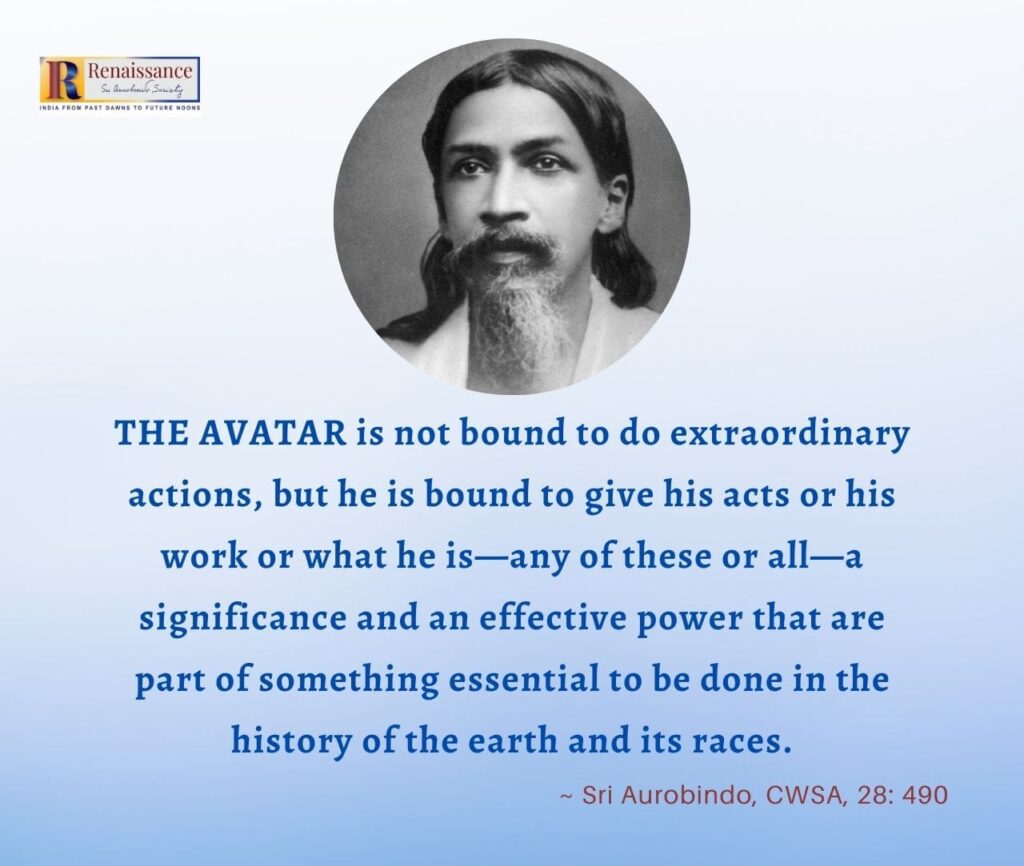
What was Rama’s main business?
In the words of Sri Aurobindo: “to typify and establish the things on which the social idea and its stability depend, truth and honour, the sense of Dharma, public spirit and the sense of order” (CWSA, Vol. 28, p. 492).
If this mighty work demanded a few sacrifices, well, he would not remain indecisive. Truth and honour demanded his kingdom and fourteen years of exile. His public spirit divorced him from domestic happiness. His leadership to make the world safe for the ideal of the sattwic human being led him to the terrible battle in Lanka.
All this he did with such a divine afflatus in his personality and action that his figure has been stamped for more than two millenniums on the mind of Indian culture and what he stood for has dominated the reason and idealising mind of man in all countries—and in spite of the constant revolt of the human vital is likely to continue to do so until a greater Ideal arises.
~ CWSA, Vol. 28, p. 492
Rama has been criticised not only for such major episodes like the killing of Vali and the banishment of Sita. Lesser questions have also been raised against his actions. Why did he shed tears? Why did he go to the tree and the creeper expressing the pangs of his separation from Sita?
Why not, Sri Aurobindo asks back with a glint in his eye. Must we impose “the colder and harder Nordic ideal on the Southern temperament which regarded the expression of emotions, not its suppression, as a virtue”? (CWSA, Vol. 28, p. 493)
The spontaneous ease with which Rama made friends with all kinds of people shows that he was not perfect in a splendidly null, negative, lofty way.
He was a faithful lover and husband to whom Sita was everything. This is an example for sattwic mankind. He was the perfect man, warm-hearted, dutiful, obedient, tender, brave and compassionate.
He was no doubt an Avatar, says Sri Aurobindo. And he was aware of his mission as an Avatar, “only uncommunicative about it” (CWSA, Vol. 28, p. 496). No miracles are performed by him. Every single episode connected with him — Ahalya gaining her original form, the breaking of Shiva’s bow, the piercing of seven trees by a single arrow — can be explained in rationalistic terms.

na kashcit na aparaadhyati
Just as Rama symbolises the ideal sattwic man (“not necessarily a perfect” man), the other characters in the epic also are not mere algebraic symbols of ethical principles. They are utterly human.
They are none of them copy-book examples, but great men and women with the defects and merits of human nature, as all men, even the greatest, are.
~ Sri Aurobindo, CWSA, Vol. 28, p. 493
Dasaratha, Kausalya, Lakshmana, Hanuman, Vali, and Sugriva and many others do commit mistakes. Under the stress of a crisis they give utterance to words not quite in keeping with their character.
Why, even Sita, the immaculate heroine, is guilty in this respect. Hence her sad words to Hanuman when the latter wishes to punish the demonesses of the Asoka grove for harassing her. They were but obeying the orders of the tyrant.
In any case, there is none in the world who is not guilty. na kashcit na aparaadhyati (Valmiki Ramayana, 4-36-11). Had she not spoken hot words to Rama in moments of anger? Had she not accused the innocent Lakshmana of harbouring ignoble desires?
Such occasional lapses do not detract from a person’s character, as long as he is motivated by nobility of intention. It is character that counts ultimately. All the great men and women of Valmiki’s world go through the fire-ordeal of dharma sankatas as well as momentary loss of their natural poise. This makes them true to life. And this inspires man not to be depressed by his own shortcomings. na kashcit na aparaadhyati!
With these words as a saviour-mantra, man tries to shed the impurities in his character in the fire of service, knowledge and devotion. And thus becomes worthy of being an inheritor of the Ramayana tradition.
The Ramayana, thus, is one of the strongest foundations of Indian culture.
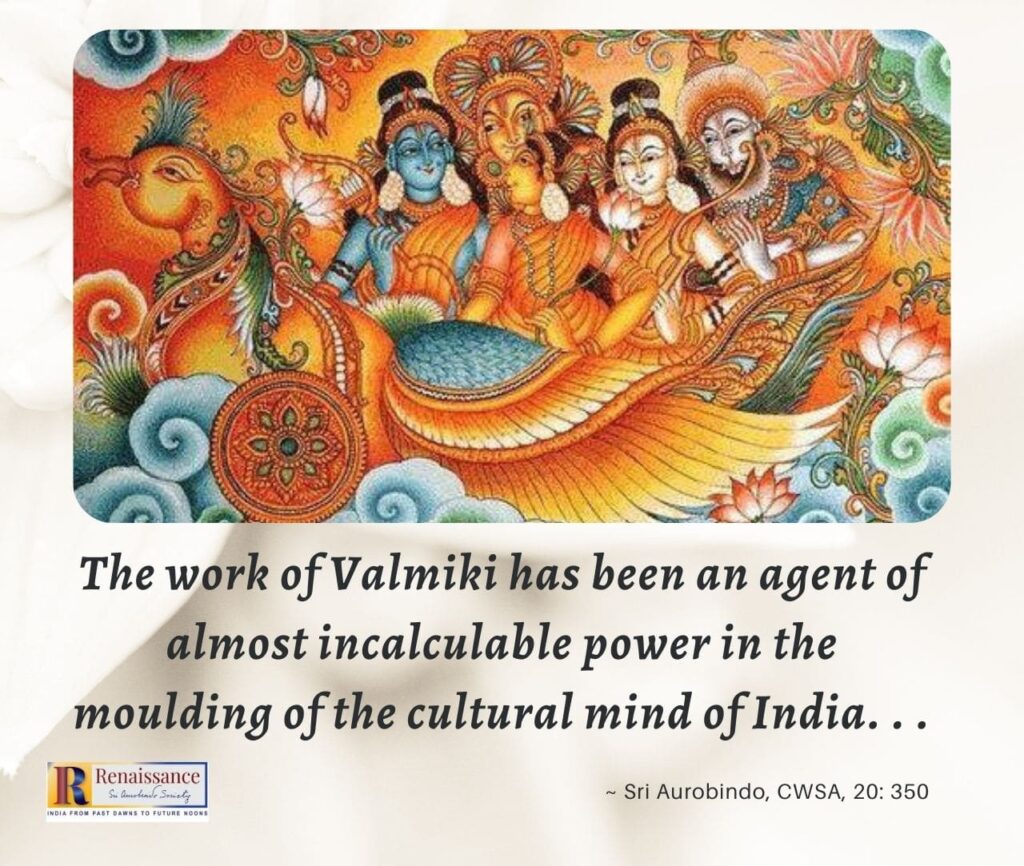
The work of Valmiki has been an agent of almost incalculable power in the moulding of the cultural mind of India:
it has presented to it to be loved and imitated in figures like Rama and Sita, made so divinely and with such a revelation of reality as to become objects of enduring cult and worship, or like Hanuman, Lakshmana, Bharata the living human image of its ethical ideals; it has fashioned much of what is best and sweetest in the national character, and it has evoked and fixed in it those finer and exquisite yet firm soul tones and that more delicate humanity of temperament which are a more valuable thing than the formal outsides of virtue and conduct.
~ CWSA, Vol. 20, pp. 350-351
CONCLUDED
READ EARLIER PARTS: 1, 2, 3

~ Design: Beloo Mehra

